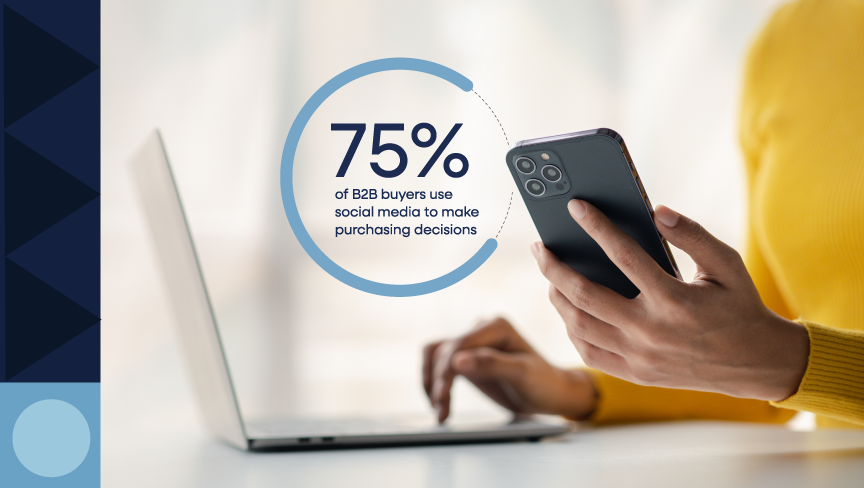When you think of social media, what’s the first thing that comes to mind?
If vacation photos, memes and dancing videos popped into your brain – same.
And sure, it can be all these things, but when it comes to B2B social media (B2B = business to business), your strategy serves as an integral part of your overall marketing plan.
It might be easy to picture how social media can be used for B2C (business to consumer) sales – a book, the hottest clothing trend or a niche home decoration goes viral and suddenly it seems like everyone wants to buy it. But when it comes to B2B social media, it serves a different purpose.
Accordingly, the strategy is slightly more nuanced.
Did you know that 75% of B2B buyers use social media to make purchasing decisions?
B2B social media typically uses different tactics than B2C organizations to be successful. Let’s discuss what they are in more detail.
B2B Social Media Marketing Strategies for 2025
When it comes to developing a B2B social media marketing strategy that will actually convert leads in 2025, you should focus on providing value, incorporating human elements, utilizing video and choosing the platforms you use strategically.
Here’s what we recommend you focus on this year:
1. Focus on Providing Value
This might not seem drastically different from B2C – after all, value is important for an engaged audience no matter what you do or sell. But B2B companies need to prioritize providing value to their customers and clients as the primary driver of their social media content. 59% of buyers prefer to do research online rather than work with a salesperson because they want to focus on solving a problem. This is why your social media strategy should help users solve a problem, and, in turn, show why your company is the best solution.
But your social media plan can provide value to more than just users who are brand new to your company.
B2B purchases are typically more expensive and complex than B2C purchases (e.g., they have a longer sales cycle and multiple decision makers or influencers), which translates to more opportunities to engage potential clients during their buyer's journey.
Additionally, 68% of consumers say they follow brands on social media to learn about new products and services. Ignoring these users in your social media strategy is a miss.
So what can you post to provide value?
A good place to start is addressing the pain points of your customer. You can provide engaging information, showcasing your understanding of your customer base and then directing them to your website to discover the products and services you offer that address those pain points.
This can be done in a variety of formats – an infographic, a long-form article, a blog post, etc. This type of content is a win-win – you show you care about and understand what your B2B customer needs, and then, boom, you also offer a solution to their problem.
.jpg?width=400&height=168&name=CMG_B2B_Research%20(1).jpg)
2. Incorporate Human Elements
AI (artificial intelligence) is everywhere, which is why it’s so important to have a human element in your social media approach.
Now, I’m not saying you shouldn’t use AI – in fact, I use it daily to streamline my processes and content creation. But I never (ever) let it serve as the be all, end all to my social media strategy.
After all, if you’re copying and pasting AI content without adding unique elements and making it more brand-friendly, you’re missing a vital opportunity to add a necessary human layer to your social platforms.
So, with this in mind, how can you use AI effectively?
AI can be a great tool to generate content ideas or captions. But there are some ethical concerns with AI and social media, especially with AI image generators. So if your organization is going to use AI, do so openly and honestly, and follow the most current best practices. My company, Conveyor Marketing Group, has established a set of AI Principles that we share with our clients and ask them to opt into (or out of, depending on their preference).
Incorporating a human touch into your social approach is important to building trust, which is crucial for B2B companies.
And social media plays a big role in trust: one study found that 78% of consumers agree that a brand’s social presence has a big impact on whether they trust that brand.
Thought leadership is a great way to add a human touch to your content – this approach highlights expert knowledge and novel ideas from subject matter experts (SMEs) at your organization, which is something that AI cannot do. In turn, this type of thought leadership social media helps build trust.
There are numerous ways to showcase your thought leaders on social media. Link to blog posts they’ve written, publish articles directly on social media sites such as LinkedIn, share graphical highlights that explain who they are and what they have deep expertise in or publish a brief video where your SME shares knowledge about a topic they’re passionate about.
This is actually a great segue into my next point, which is…
3. Utilize Video
Both short-form and long-form videos have become popular across social media platforms. 86% of social media users spend 25% or more of their time on social media watching videos.
And video is not just for entertainment – 88% of marketers that use video found a positive ROI.
Just make sure that the videos you create are providing value to your target audience. For example, you could create a video highlighting a new product (fun fact: 72% of users choose video over text for learning about a new product or service, so this could be a great starting point). You could also create thought leadership videos, sharing highlights or recordings of an event (perhaps one of your SMEs is speaking at an industry conference?), telling your company’s story and more.
.jpg?width=397&height=312&name=CMG_B2B_videoROI%20(1).jpg)
4. Pick Your Platforms Strategically
For B2B companies, LinkedIn is a great platform to start with. Everyone agrees: 50% of B2B buyers use LinkedIn as a trusted source for making purchase decisions, and 40% of B2B marketers say it’s the most efficient tool to generate quality leads. LinkedIn has a large, diverse user base that can help you reach your target audience.
While LinkedIn is a great place to start, social media is most effective if you figure out where your audience is.
Yes, a lot of your audience might be on LinkedIn, but there could be other highly-used platforms that would allow you to interact with your target audience, or let you interact in different ways and with slightly different messages.
YouTube, for example, is frequently visited by a wide range of age groups and offers both short- and long-form videos, while X is really popular for journalists who are looking for bite-sized information.
Some platforms that you could check out include:
- YouTube
- Threads
- X (Twitter)
- TikTok
23 Creative B2B Social Media Content Ideas for 2025
Now that you have a roadmap for your strategy, what should you be posting? From customer stories to employee spotlights to ask-the-expert sessions, here are 23 creative B2B social media content ideas you should steal for this year:
1. Customer Success Stories
Create short videos or posts that highlight real customer success stories. Show how your products or services solved a client’s problem, providing tangible results and ROI.
We love this feature reel from Electronic Payments highlighting the different types of customers their product can serve.

2. Behind-the-Scenes Tours
Offer a peek behind the curtain at your company’s day-to-day operations. Whether it’s how your team collaborates or how your product is made, this type of content humanizes your brand.
We love this tour video from Puritan Medical Products showcasing their original factory in Guilford, Maine!

3. Employee Spotlights
Showcase your team members by sharing their stories, expertise and passions. This can help to create a connection between your company and your audience by showing the people behind the business. Spotlight their role, their hobbies, their families or pets and so much more.
Here’s an example from our own marketing.

4. Industry News Commentary
Share your thoughts on the latest industry trends or news. Whether it’s a new regulation or technological advancement, positioning your brand as a thought leader keeps your audience informed. New legislation, regulations, laws, research studies or announcements are also ripe for your commentary!
Here’s a great example from CRISP DC.

5. Client or Employee Takeover Day
Allow a trusted customer or client to “take over” your social media for a day. This could involve them sharing their experience using your product or showing how it benefits their business.
This kind of content is especially engaging if you use Stories, Reels, and Threads, which can be a playful way for someone to ‘take over’ your brand. Encourage your employees, partners and customers to engage with the content for better reach.
Here’s an example from Sculpt, which lets employees regularly take over their Instagram accounts.

6. Interactive Polls and Surveys
Engage your audience by creating interactive polls and surveys. Use the results to spark discussions or guide future content based on what your audience wants to see more of.
Check out how HubSpot integrates polling data right into their feed.

7. Infographic Educational Series
Create a series of infographics that break down complex topics into digestible, easy-to-understand content. These can be shared over time to build a cohesive learning journey.
Consider using multi-page posts for engaging infographics directly within the LinkedIn platform, like this awesome example from Semrush.

8. User-Generated Content Contests
Encourage your clients or audience to share how they use your product or service by hosting a content contest. Or, simply ask for engagement to win. You can give away a variety of prizes including features (if your audience is large enough!), free products/services or even gift cards.
Feature the best submissions on your social platforms!
Check out this awesome contest example from aPriori.

9. Live Demos and Tutorials
Host live demonstrations or tutorials showcasing your product in action. This gives potential clients a firsthand look at the benefits and functionality.
Demos don’t have to be long, boring videos. Check out how SoftBank promotes their humanoid robot, Pepper, here.

10. Collaborations with Industry Influencers
Partner with industry influencers for co-hosted live streams, webinars or guest posts. Leverage their audience to boost your credibility and expand your reach.
Tagging the influencers you’re partnering with can help amplify the reach of your article, getting your brand in front of new qualified buyers.
Here’s a great example from 6GWorld.

11. Virtual Product Launches
Create excitement by launching new products or services through virtual events streamed on social media. Include sneak peeks, live demos and Q&A sessions.
HubSpot is famous for launching products virtually. Check out this example where they highlight new functionality and features in a 5-page interactive LinkedIn post.

12. Data-Driven Posts
Share insights and statistics relevant to your industry. Data can validate your claims and position your company as a knowledgeable leader in your field. Data can look like surveys, polls, third-party studies and so much more.
No one does this better than Egon Zehnder. Check out this example below.

13. Sustainability Initiatives
Highlight your company's sustainability efforts or corporate social responsibility (CSR) and environmental, social and governance (ESG) programs. This content tends to get excellent engagement.
Here’s a subtle example we love from Messer.
14. "Day in the Life" Content
Give your audience a behind-the-scenes look at what a typical day looks like for your team or a key client. It adds a personal touch to your brand's story. “Day in the Life” content could look like a complete takeover of your social media for a day, or simply a quick snapshot into what your employees are doing.
We absolutely love this example from Puritan Medical Products highlighting their management team stepping up to help pack an extra large order!

15. Thought Leadership Series
Publish a series of in-depth blog posts written by your internal experts, and promote them via social media. This helps demonstrate your industry knowledge and build trust. But lengthy posts don’t have to be the only medium you rely on. Consider short videos, webinars and more to amplify the voice of your team’s leaders. Promoting your company’s founder is one way to amplify your brand in a human-centric way.
Check out this thought leadership post and article from our founder, Jason Johnston.

16. Creative Testimonials
Don’t just post a standard testimonial—get creative. Share video testimonials or compile multiple client reviews into an engaging carousel post. Shorter testimonials can be designed as a social image. You can also highlight results and link to a longer version.
We love this example from CuraMedix.

17. "Ask an Expert" Sessions
Dedicate a social media session to answering audience questions. This can be through live streams, Stories or a dedicated post where followers can submit queries. Or, if you have an expert on hand, ask them to provide commentary on a timely and relevant subject. You can launch your “Ask an Expert” session as a weekly, monthly or quarterly series to keep your audience engaged and build thought leadership among your team.
Check out this “Ask the Expert” session with our very own Kate Moore on how AI is disrupting the marketing industry.

18. Trend Predictions
Share your company’s predictions for future industry trends and how they’ll impact your audience. Being forward-thinking helps your brand stay relevant. Trends don’t have to be boring list posts either. Try promoting your quarterly, bi-annual or yearly trends as a webinar, overview video or as a fun ‘jam session’ like Dan Tyre and Joshua Curcio did here.

19. Virtual Tours of Facilities
Create immersive virtual tours of your production facilities, headquarters or offices. Use these tours to showcase innovation and transparency within your company. But tours don’t just have to be for your facility. You can tour events, trade shows and more!
Check out this tour post from Sullivan-Palatek, Inc.

20. Case Study Highlights
Break down key takeaways from your company’s case studies into easily digestible social posts. Provide solutions and measurable results to highlight your brand’s impact. You spend so much time building out your case studies, don’t let them just waste away on a shelf.
Here’s how Kardex successfully shared the ROI of their automated storage and retrieval systems – gaining 161 reactions and 11 reposts!

21. Interactive Quizzes
Design quizzes that guide your audience through a fun way to learn about your product offerings. For example, “Which of our solutions fits your business needs?”
We love this example from Acumentice.

22. Event Recaps
After attending or hosting a B2B event, create a recap post or video with highlights, key takeaways and insights to keep the conversation going. You might consider using a LinkedIn article or newsletter to boost engagement with your direct audience.
Check out this event recap post from Jessika Parry on the INBOUND conference.

23. Monthly Industry Roundups
Curate the latest industry news, articles and developments in a monthly roundup. This keeps your followers informed and positions your brand as a resource for valuable industry content.
SubjectLine.com does a great job of this, providing regular email marketing trend updates including fresh tips, podcast episodes, blog links and more.

Are you ready to revamp your company’s social media strategy? Check out this comprehensive B2B organic social media checklist to see how you stack up.





